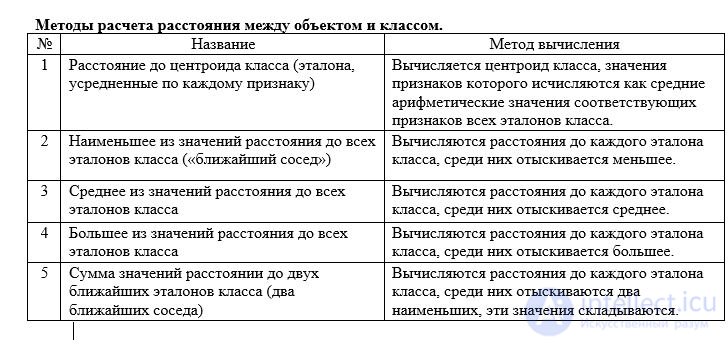Lecture
The task:
1. Develop a decision-making algorithm in a deterministic recognition system based on the use of known geometric measures of proximity.
2. Run the software implementation of the developed algorithm, debug the program.
3. Run control recognition of unknown objects by their feature vectors.
4. To compare the efficiency of making decisions on the assignment of unknown objects to given classes for various methods of calculating the distance between an object and a class. Determine the best combination of the proposed.
Stages of sequential work:
1. Determine the values of signs of five standards for each of the four classes.
2. Display on the graph certain standards of all classes, instances of each class in the form of a point of a certain shape and color.
3. Implement the sequential interactive introduction of feature vectors of unknown objects that need to be recognized and assigned to one of four classes (feature values can be determined by pressing the mouse button, asking the user or setting fixed values in the code).
4. Implement the functions for calculating the degree of proximity between an unknown object and a given object of a particular class (methods for calculating the degree of proximity between two objects are different).
5. Implement the function of calculating the distance from each unknown object with a given class (methods for calculating the distance between an object and a class are different).
6. Implement the ability to select combinations of methods for calculating the degree of proximity and distance between objects.
7. Calculate the distance from the unknown object to each of the four classes.
8. Determine the class, the distance from the unknown object to which the minimum (in accordance with the selected combination of methods for calculating the measure of proximity between objects and the distance between the object and class).
9. Show the recognized object on the graph as a point, in the form and color of which coincides with the class to which it belongs.
A metric space is a set in which between any pair of elements a distance is defined that has certain properties, called a metric .
Metric space is a pair where
- many, and
- numeric function, which is defined on the Cartesian product
, takes values in the set of real numbers, and is such that
Wherein
.
for all
and
,
then the symmetry axiom follows from the axiom of identity and inequality of a triangle.
Usually the distance between points and
in metric space
denoted by
or
.


Comments
To leave a comment
Classification and recognition
Terms: Classification and recognition